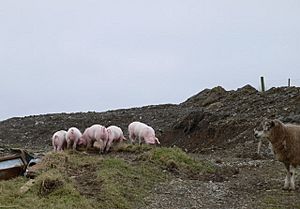Welsh pig facts for kids

Pigs on a farm in Hafod, Wales
|
|
| Country of origin | Wales |
|---|---|
| Traits | |
| Weight |
|
|
|
The Welsh pig is a special type of domestic pig that comes from Wales. It's a big, white pig known for being tough and able to live outdoors on farms. It has a long body that looks a bit like a pear, and its ears flop down. People first wrote about this pig in the 1870s. After a report in 1955, it became one of the most popular pigs for breeding in the United Kingdom.
Later, in the late 1900s, fewer people wanted Welsh pigs. This was because people wanted leaner meat, and the Welsh pig was thought to be too fatty. By 2005, there were so few Welsh pigs that they were considered endangered. The Rare Breeds Survival Trust started to help them. Since then, their numbers have grown a bit. By 2012, there were over 1,000 registered breeding pigs.
History of the Welsh Pig
Pigs with floppy ears have lived in Wales for a very long time. The Welsh pig comes from different towns in Wales, like Montgomery, Cardigan, Carmarthen, and Pembroke. The first time the Welsh pig was mentioned in books was in the 1870s. At that time, pigs from Wales were taken to Cheshire to be fattened up. People said that Welsh pigs were usually yellow-white, but some had black and white spots.
During World War I, it was hard to get bacon and pork. So, in 1918, a group called the Glamorgan Pig Society started in South Wales. Their goal was to help grow more pigs. Two years later, another group, the Welsh Pig Society for West Wales, was formed. Farmers in different parts of Wales were raising similar pigs. So, in 1922, these two groups joined together to form the Welsh Pig Society. This new society published its first book about the breed in 1924. These groups wanted to protect and promote the Welsh pig. They also wanted to show that the Welsh pig was good for commercial farming. In 1952, the Welsh Pig Society joined a bigger group called the National Pig Breeders Association.
After World War II, the number of Welsh pigs grew a lot. This happened because it became easier to get good food for them. Many more licences were given for Welsh boars (male pigs). The number of purebred Welsh sows (female pigs) also increased greatly. This pig breed became very popular in the middle of the 20th century. In 1955, a special committee suggested that the government should focus on three main pig breeds: the Large White, the Landrace, and the Welsh pig. This decision caused other native pig breeds to become less common.
In 1973, the Rare Breeds Survival Trust was created. This group works to stop many traditional British animal breeds from disappearing. Today, the Welsh pig is not often kept as a pure breed. Instead, it is often used to cross-breed with other pigs. By 2005, there were very few purebred Welsh pigs left. They were declared "endangered" and later called a rare breed. This happened because people's eating habits changed. Also, many hybrid pigs were being produced by big farms, which meant fewer purebred pigs were needed. In 2008, there were 373 registered female Welsh pigs and 108 registered males. By 2012, these numbers had increased to 837 females and 238 males.
What Welsh Pigs Look Like
The modern Welsh pig has a head that is not too wide. Its ears flop down, and its nose is straight. The ears do not quite reach the end of its snout. Its neck is quite deep, and its shoulders are flat on top. It has a long, strong, and level back. The front legs are set wide apart, and its chest is deep. The tail is thick where it starts and smooth. The bottom line of the pig's body is straight.
The Welsh pig has strong muscles in its back and thick sides and belly. Its back legs are strong and firm, with well-rounded hams. The back legs are not too long, are straight, and have good bones. They are also set wide apart. The pig's skin is thin and smooth, and its coat is fine and straight. Welsh pigs are usually white, but sometimes they have a few black spots. Both male and female Welsh pigs have at least twelve teats.
Male Welsh pigs, called boars, usually weigh about 250 kg (550 lb). Female Welsh pigs, called sows, weigh between 150 to 200 kg (330 to 440 lb). In the 1800s, people described the Welsh pig as having long legs and being a bit like a razorback. They also said it grew slowly and had coarse hair. The Welsh pig is a tough animal that does well both living indoors and in outdoor farming systems.
Uses of the Welsh Pig
The Welsh pig is raised on farms to produce high-quality bacon and pork. It gives a lean body with a good amount of meat compared to its total weight. It has enough fat to make the meat juicy and tasty, but it's not too fatty. Even when these pigs grow to be heavier, their meat is still good quality.
Other good things about the Welsh pig include that it turns its food into meat well. The sows are also good mothers, and many of their piglets survive. Female Welsh pigs can be used in breeding programs with Large White or Landrace boars. This creates cross-bred piglets that grow fast. Male Welsh pigs can also be used with other rare pig breeds. This helps to produce leaner, faster-growing young pigs with better body shapes.

